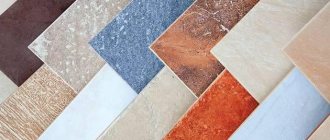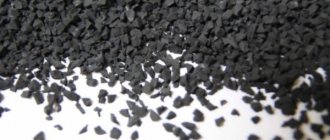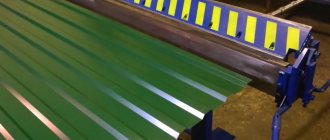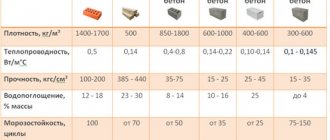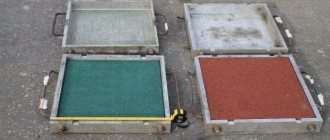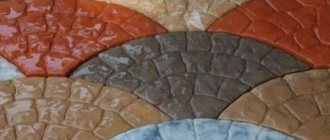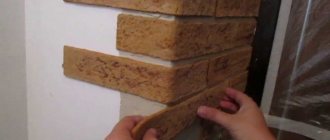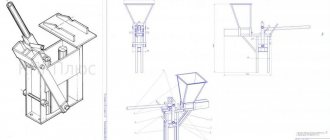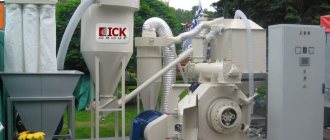The production of polymer sand products is a young and promising industrial sector in the Russian and world markets.
Advantages of polymer sand products:
- Environmentally friendly.
- Resistance to physical, chemical and thermal influences.
- Durability.
- Various applications.
The main components of polymer sand tiles are sand, polymer and pigment. It is better to take polymer for the production of tiles from recycled materials, which reduces the cost of purchasing it. At the same time, the quality of the products improves.
Necessary equipment for tile production
All technical equipment does not have bulky shapes, so it can be used in mini-workshops. And the process itself does not require deep knowledge and skills in technology, which will certainly suit an individual entrepreneur.
Let's consider the main apparatus for equipping the technological process.
Device for crushing polymer. Rotary crushing units can crush all types of polymer products. Their productivity ranges from 100 to 1000 kg per hour. The cost of equipment is from 100,000 rubles.
Mixer. Allows you to quickly mix all components until smooth. The composition and proportion of the mixture are determined by the technologists and the manufacturers themselves, and there is no universal recipe. When choosing a concrete mixer, it is better to give preference to specialized brands with a hopper and a belt conveyor, which allows you not to interrupt the production process. The cost is about 40,000 rubles.
Melting and heating unit, APN or extruder. The polymer sand mixture is placed in an extruder, where it is mixed again and heated to 200-250 degrees. It is necessary to take into account that the polymer raw materials must have the same melting point. The molten mass is the consistency of a tight dough, which is called thermoplastic composite. This mass is extruded through the extruder head onto a pallet, where the operator cuts off a part and weighs it on a scale (the maximum weight of the mass should be no more than 2 kg). The productivity of the devices can reach 1000 kg/h. The cost of a melting and heating unit is from 350,000 rubles.
Polymer tiles
Vertical press and molds included in the molding unit. There are various types of pressing equipment on the market with forces ranging from 60 to 400 tons. The pressing time is a few seconds. It is necessary to take into account the variability of the work table if the manufacturer produces various types of products from a polymer-sand composite. The press mold is made of alloy steel, which guarantees durability and quality. The cost of a hydraulic press is from 150,000 rubles, press molds from 1,500 rubles per piece.
The cost of devices of the same type of purpose may vary depending on power, degree of automation and productivity. Equipment configuration options should be selected taking into account the scale of production.
Pros and cons of this coating
Like any product, polymer sand tiles have their advantages and disadvantages. Positive properties include:
- The material is resistant to mechanical damage, chemical attack and large temperature changes.
- Environmentally friendly, because even at stable high temperatures, the material does not emit harmful substances into the atmosphere. In addition, the waste plastics used create less of a burden on the environment.
- Durability and high strength characteristics. Thanks to the correct selection of mixture proportions and adherence to technology, the service life of the tiles is about 50 years.
- Safety thanks to non-slip surface.
- Decorative effect due to the variety of shapes, colors and patterns.
- Possibility of laying both manually and using tile-laying machines.
- Maintainability – ease of dismantling and replacing individual elements if necessary.
- Cost-effective due to the availability of raw materials and simplicity of manufacturing technology.
Equipment options
For mini-workshops, the basic package includes:
- Concrete mixer.
- Melting and heating unit.
- Press and press form.
- General purpose scales.
This configuration will be sufficient to start production. But for full-fledged work, it is recommended to purchase also a device for crushing polymers. An individual entrepreneur can do it alone to reduce the cost of hired workers. But this will reduce the volume of output.
There are configuration options with minimal investment, for example, it includes an APN with a power rating of 15 kW and a hydraulic press with a force of 63 tons.
Large factories can purchase equipment with maximum power and a high degree of automation of productivity. For example, it is possible to equip the production with several hydraulic presses, various press molds and APN with a power of up to 54 kW.
Option for large enterprises:
- Radial crusher.
- Agglomerator for converting polymer chips into granules.
- Concrete mixer.
- Extruder.
- Hydraulic Press.
- General purpose scales.
- Cooling system.
The minimum amount of investment in production, taking into account commissioning processes, is approximately 800,000 rubles for an individual entrepreneur. For larger factories it will be higher.
Finished tiles
Tips for organizing production
At the first stage, you need to select a location for installing the equipment. The room must have a power supply line of the required power with an optimal area for the placement of machines. Equipment for the production of polymer sand products can be selected from different manufacturers. Some of them offer complexes where the heating and molding process is combined in one design. This significantly reduces labor costs, since there is no operation to move the heated mass from the melt line to the press.
The choice of a specific type of product depends on the state of demand. Currently, paving slabs are especially popular - they are used both in public utilities and in private buildings. If it is necessary to expand the range of products, you can purchase new molds. However, this step must be calculated, since their cost can reach several hundred thousand rubles.
Calculations of costs, income and payback
When starting a business from scratch, you need to take into account the cost of the most necessary equipment
| Name | Cost, rub. |
| Polymer crusher | 95 000 |
| Drying chamber for sand | 215 000 |
| Thermal auger mixer | 200 000 |
| Electronic balance | 35 000 |
| Forming line | 152 000 |
| Shelving | 20 000 |
| Total: 717,000 |
Production of material
The raw materials for the manufacture of polymer tiles are simple and affordable components:
- various pigments;
- polymers;
- quartz sand.
To reduce the cost of purchasing components, you should use secondary raw materials, which will be cheaper, but will not spoil the quality of the products.
There is simply no exact recipe for making sand tiles as such. Each manufacturer independently develops its composition. The best option is to draw up a recipe from your own experience, but experts also recommend seeking the help of a technologist.
The tile production technology is quite simple. To comply with it you do not need any special knowledge or skills.
Since the polymer included in the tile has a neutral chemical composition, only nitric acid serves as a solvent for it under certain conditions. To form a homogeneous mixture with sand, the polymer must be melted at a temperature of 180 degrees and atmospheric pressure. This process is called extrusion.
To color tiles in different colors, I use various inorganic substances: iron oxide to give a brown, red or orange color, chromium oxide to get green, titanium dioxide to give the product a white color.
Do-it-yourself production of polymer sand tiles is carried out as follows:
- crushing or agglomeration of raw materials. But if you purchase polymer chips, then this stage can be easily avoided;
- mixing components using a concrete mixer;
- melting the mixed mass in the APN (extruder);
- pressing products into molds;
- movement and storage of finished products.
Cost and profitability of this business
When opening a business for the production of polymer-sand tiles in medium-sized and large cities of Russia, such as Orsk, Kirov, Samara and Izhevsk, the first step is to take into account the demand in the region.
In addition, it is necessary to assess the availability of raw materials, calculate financial investments in equipment and premises, and calculate the cost of the finished product.
For the listed cities, the average production cost is about 150-300 rubles per 1 m 2 of tiles. The sales price varies from 300 to 1150 rubles per 1 m2 , depending on its functionality and strength.
Based on these figures, the profitability of a business with proper organization of production can exceed 100%. The payback for this type of activity takes from 2 to 6 months, even taking into account the impressive initial investment.
Considering the development and growth of construction, both private and public sectors, these products will always be in demand. Simple technology, accessible and inexpensive raw materials, high quality characteristics of the finished product - all together make this business attractive both for starting and for developing a new direction on an existing basis.
Source: https://xlom.ru/oborudovanie/dlya-proizvodstva-polimerpeschanoy-plitki
COST OF ENERGY AND MATERIALS
Raw materials for tile production:
- Polymer granules or flakes
- Construction sand
- Coloring pigment
Composition of the polymer sand mixture:
- 75% - sand,
- 0.42% - pigments,
- 24.58% - polymer (one ton contains 245.5 kg of polymer).
Average price in Russia:
- sand – 0.32 rub. per kg,
- pigment – 80 rub. per kg,
- polymer – 18 rub. per kg.
In total, the cost of raw materials (polymer + sand + pigment) per ton is 5,000 rubles.
Weight of tiles 1 sq.m. 9 pieces * 1.8 kg = 16.2 kg. Thus, the cost of raw materials per 1 m2 of tiles is 81.00 rubles. For 1 piece 9 rubles.
Advantages of polymer tiles
Polymer sand tiles consist of the following components:
- quartz sand (3/4 of the composition);
- high-density polyethylene (25% of the composition);
- a small part of other petroleum products.
This composition makes the material plastic and resistant to negative external influences.
The advantages of the product include
- durability – the polymer coating lasts up to 30 years;
- stability - the material is not afraid of frost, moisture, heavy loads, liquids containing acid and oil;
- Decorative – tiles are often made in any shape. Moreover, it often has a glossy, matte or structured surface. And also when making polymer tiles, craftsmen can use a wide range of colors;
- no toxic fumes when exposed to direct sunlight;
- reusable and easy to repair if damaged;
- ease of cleaning the coating (tiles are easy to clean);
- wide scope of application. Polymer sand tiles are used as a decorative covering for private courtyards, parking lots, playgrounds and sidewalks in public places.
Equipment for the production of polymer sand tiles
Polymer sand paving slabs are superior in their characteristics to conventional cement paving slabs. Polymer sand tiles are durable, frost-resistant, have a wide range of colors, can be of any shape and size, with a variety of patterns. The method for producing polymer sand tiles is simple and consists of several stages: preparing the mixture components, mixing the initial components, melting the mixture, molding and pressing the products, the hardening process, storing the finished product.
Polymer sand tile production technology
To produce polymer sand tiles, three components are required: polymers (primary or secondary), sand of a uniform fine fraction without clay inclusions, and heat-resistant pigment. Polymers suitable for the production of tiles are HDPE (low-density polyethylene), LDPE (high-density polyethylene), and crushed film. The use of recycled polymers will help save on the purchase of raw materials and solve the problem of waste disposal. Secondary polymers are obtained by crushing and granulating industrial waste and polymer products (pipes, containers, packaging materials, films, etc.). At the first stage, the polymers are crushed or ready-made polymer crumbs are purchased.
Part of the equipment
THE STANDARD PACKAGE INCLUDES: Sand heating installation with a trestle (designed for heating sand):
- Overall dimensions: 3000x3400x3100 mm
- Heating power: 19.2 kW
- Sand volume: 0.13 m3
- Hopper weight (without sand): 400 kg
- Productivity: 150-250 kg/h
Polymer concrete mixer (designed for a mixture of sand and polymers and extrusion of the finished mass):
- Overall dimensions: 3500x900x1400 mm
- Motor power: 15 kW
- Heating power: 12.5 kW
- Weight: 907 kg
- Productivity: 150-500 kg/h
Press 100 t/s (one for all molds of products, designed for pressing polymer-sand mass into finished products):
- Overall dimensions: 2200x1450x960 mm
- Weight: 2.5
- Drive: 4 kW
- Pressing force: 60-100 t/s
Control panel (designed to control the technological equipment of the line):
- Overall dimensions: 660x510x1900 mm
Agglomerator of polymeric materials:
- Overall dimensions: 1200x620x1600 mm
- Motor power: 18.5 kW
- Weight: 450 kg
- Productivity: 150-200 kg/h
Designed for grinding waste polymer film and obtaining an agglomerate suitable for further processing in extruders and injection molding machines into finished products.
Grinder of polymers and films (designed for grinding polymers for the further production of a polymer-sand mixture):
- Overall dimensions: 1325x1156x1843 mm
- Motor power: 15 kW
- Weight: 1 t
- Productivity: 180-200 kg/h
Molds - according to the mold catalogue.
Received products: tiles, roofing elements of varying complexity, paving slabs, road curbs, road bollards, manholes, small architectural forms, road construction elements.
INITIAL INVESTMENT
The total cost of the equipment set, including the cost of turnkey commissioning works, is: 2,708,780.00 rubles excluding VAT.
| Name | price, rub. |
| Commissioning works | 50 000,00 |
| APN | 567 000,00 |
| Hydraulic press | 947 280,00 |
| Press mold PP "Romanskaya" ordinary tiles Press mold PP "Ridge element (initial/through/end for tiles "Romanskaya" (single mold) | 273 000,00 273 000,00 |
| Crusher of raw materials - waste * | 385 000,00 |
| Mixer 1 cubic meter | 213 500,00 |
| TOTAL | 2708780,00 |
Disadvantages of polymer sand tiles
Despite all the listed advantages, polymer sand tiles also have a number of disadvantages that need to be taken into account before purchasing:
- the surface may erode . Over time, the thickness of the shingles may become thinner due to exposure to ultraviolet rays. But considering that the thickness of the product is not so small and the erosion process is slow, this can hardly be considered a serious drawback;
- each tile of polymer sand tiles weighs up to 2 kg , which can cause a lot of trouble during installation and transportation;
- Although tiles tolerate climate change well, when temperature changes occur, they undergo linear deformation . As a result, depressurization of the lock connections may occur, which will cause the roof to leak. This is perhaps its main drawback.
It will be good to be under such a roof in any weather; it will be cool in the heat and warm in winter. Therefore, it is often used for ceilings in attics and attics.
Rules for installing polymer tiles
Installation of polymer tiles is also quite simple. Before starting installation, you need to build a sheathing from unedged boards or timber; it is the direct basis for laying the tiles.
Each polymer shingle tile has special protrusions on the top of the back side, with the help of which it is attached to the sheathing. The tiles are secured to each other with side locks. As a result, we get a continuous roofing covering.
It is best to start laying the material from the bottom row. The elements should not be fastened to each other very tightly, while leaving room for free movement. This will help avoid deformation of the material due to different weather changes.
On some roofs, streaks of rust are noticeable; to avoid this, it is recommended to use galvanized nails or anodized screws when installing.
Types of tiles
The oldest roofing material, which gives its name to a number of modern sheet roofing materials, has always been made from clay. Today, it is practically not used due to the long production time, the complexity of installation, the large percentage of losses resulting from the fall of fragile dies, and the inability to create an ideal, leak-free monolithic layer.
Despite all these disadvantages of heavy natural material, manufacturers are trying to embody its main qualities in modern analogues. Best qualities of clay tiles:
- protection from rain and wind noise;
- preservation of the indoor microclimate due to the clay’s resistance to heating and excessive cooling;
- the ability to replace only damaged roof elements.
The tiles can be copper, ceramic, cement-sand, metal, composite, polymer-sand, bitumen.
PS And if production is not your option, but you just need to buy tiles for your home. The best option is www.schiefer.ru! “Dr. Schiefer” is a company producing ceramic tiles. Visit the website and choose for any needs!
Modern materials have strict geometric outlines, regardless of the pattern reproduced using molds, metal rolling machines and other equipment. This greatly simplifies the joining of sheets into a single monolithic covering. However, corrugated sheets are laid overlapping, like slate. The difference lies in the subtlety of the materials, due to which a modern tiled roof looks attractive. And at the same time, protection from rain is more effective.
Metal tiles
One of the most popular roofing materials in summer cottage construction is metal tiles. Its production does not require a large amount of specialized equipment and space. A metal rolling machine with a specific pattern for profiling and a hydraulic knife for cutting to size are sufficient. Small production can be located on 20 m². The main thing is that the concrete floor is smooth and the raw materials are cheap and of high quality.
The production of metal tiles from cold or hot rolled steel to the release of the finished roofing sheet is possible only at large enterprises, which is associated with large financial investments. Composition of multilayer material:
- the basis;
- zinc;
- passivating layer;
- primer;
- coloring
Since some layers are duplicated on both sides, it turns out that a sheet of metal roofing material consists of 8 layers. For external painting, polyester or pural spraying is used. Painting the inside is done without a primer layer with cheaper paint.
Sheets of galvanized steel with a thin polymer coating are good for cold roofing. For permanent residences, metal tiles are suitable only if the attic space is insulated with SIP panels. They will muffle the sounds of rain and provide optimal thermal insulation.
Conclusion! Metal tiles are suitable for decorating warm roofs, gazebo roofs and summer houses. For year-round homes (in areas of the temperate climate zone), higher quality material is needed.
Polymer sand tiles
The high quality of the material is ensured by only two ingredients and the manufacturing method. The material consists of coarse sand and polyethylene. As a result of hot pressing, the material is homogeneous and has no pores. Drying of the material occurs in a confined space where there is no access to moisture.
The color variety of polymer-sand tiles is given by mineral dyes added to the enclave where the main ingredients are mixed. Due to the lack of air access, each grain of sand is enveloped in a layer of polyethylene. Such material is not only not afraid of shaking on the roads, but also falling from the roof will not lead to damage.
The weight of one standard sheet of sand roofing material is 22 kg. Unlike fragile slate, this material can be cut, nailed with tar nails, heated to +70° C and cooled to – 50° C. Neither heat, nor cold, nor acid rain will affect the quality of the material, the service life of which is expected to be at least half a century.
The peculiarity of polymer sand tiles is that they do not have characteristics that are not required during operation. It only protects the roof of the house from wind and moisture penetration, muffles impact sounds, and does not heat up in the sun to critical temperatures.
Slate
This material can safely be called a transitional form from natural clay tiles to its modern analogues. Moisture-proof cardboard is used as the basis of this material. On both sides it is pressed with sand-cement mortar with chemical additives. For many decades, slate was considered the best roofing material. It perfectly protected from winds, moisture, and shock sounds. Its only drawback is its fragility. Loss during transportation of up to 10% is an acceptable norm.
A little later, rubber slate appeared. Its advantages were the absence of warping, ease of processing and adjustment to size, but it became very hot in the sun, became brittle in severe frosts, and its installation required a monolithic covering of the logs with wood.
The service life of both types of slate indicated by the manufacturer was in great need of adjustment. After all, the integrity of the roofing material depended on the air temperature, the severity of changes, the amount of precipitation that fell in winter, and the angle of the roof slope.
Modern rubber tiles are a product of recycled rubber, which was previously a car tire. Its production can be established at regeneration plants, the demand for whose services has dropped significantly over the past 3 decades. But the equipment remains, it can be used. The process is labor-intensive and cannot be done without specialized machines. The task is this:
- cord removal;
- tread cutting;
- polishing the resulting elements;
- coating with slate powder or wood flour;
- heat treatment.
This material has its admirers not only among ardent environmentalists. Builders like rubber tiles for the presence of side grooves, which simplify the installation of monolithic roofing sheets.
Ceramic tiles
Working with natural clay requires maintaining a certain climate regime in the room. The raw materials coming from the quarry are heterogeneous, which requires repeated crushing, drying, moistening, and sifting. All this is easier to do using powerful specialized units in a sufficient workshop space.
Before starting molding, it is necessary to impart a certain plasticity to the raw material, which may require chemical additives and plasticizers. Additional costs – payment for the services of a technologist. Only after many days of preparation of the raw materials can we begin molding and firing. The temperature in the kiln is maintained between 450-600° C, and during the secondary firing, after glazing, it should be at 1000° C.
We recommend reading:
- production of artificial marble
- making Lego bricks at home
- brick making
- how to organize a polyethylene production plant
- foam production
Flexible tiles
Composite material, which includes: rubber, plastic waste, bitumen impregnation. Fiberglass and basalt are used for the base. The manufacturing method is technological, multi-stage.
Cement-sand tiles
The main components are Portland cement, quartz sand or limestone, water, iron oxide. The technical characteristics of the material practically coincide with those of ceramic products. Only the cost of this analogue is much lower.
The production of this roofing material is impossible without expensive specialized equipment necessary for molding under high pressure. A drying chamber is needed to dry the material for 8-12 hours at a consistently high temperature. After 3-stage painting, cement-sand tiles must be dried for a month in a well-ventilated area.
Composite tiles
Rolled steel sheets hidden behind an aluminum-zinc alloy. The thickness of the coating with mineral granules is ≈ 20. Such a complex composition gives the steel sheet protection from corrosion, mechanical damage, and fading.
